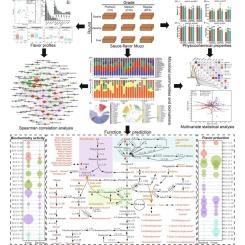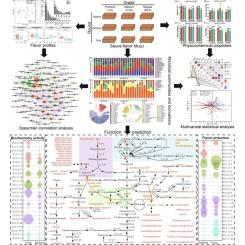研究不同品级、不同生产周期调味木曲微生物组和挥发物特征的变化
IF 9.8
1区 农林科学
Q1 CHEMISTRY, APPLIED
引用次数: 0
摘要
木曲是高温大曲的起动机;然而,其质量形成的机制尚不清楚。为此,研究了品位和圆度对木曲质量的影响。生物化学活性与等级密切相关,而水分和脂肪含量与圆有关。挥发分也受到等级的显著影响,三甲基吡嗪、2,3-丁二醇和己酸甲酯等不同化合物的水平与等级呈正相关。相比之下,细菌和真菌的多样性分别受等级和圆形的调节,导致在共发生网络中有不同的相互作用模式。酸度和氨基酸氮水平是驱动群落聚集的关键因素,其中Virgibacillus、Kroppenstedtia、thermo放线菌、Aspergillus和Byssochlamys是主要的风味产生菌。功能预测表明细菌群落在风味合成中起关键作用,真菌群落在碳水化合物代谢中起关键作用。这些发现为通过木曲分级策略提高大曲质量提供了新的见解。本文章由计算机程序翻译,如有差异,请以英文原文为准。


Investigating the variations in microbiome and volatilome characteristics of sauce-flavor Muqu across different grades and production rounds
Muqu is the starter of high-temperature Daqu; however, the mechanisms underlying its quality formation remain unclear. Therefore, the effects of grade and round on Muqu quality were investigated. Biochemical activities were closely associated with grade, while moisture and fat content were linked to round. The volatilome was also significantly influenced by grade, with levels of differential compounds such as trimethylpyrazine, 2,3-butanediol, and methyl hexanoate showing a positive correlation with grade. In contrast, bacterial and fungal diversities were regulated by grade and round, respectively, resulting in distinct interaction patterns within the co-occurrence network. Acidity and amino acid nitrogen levels were key factors driving community assembly, and Virgibacillus, Kroppenstedtia, Thermoactinomyces, Aspergillus, and Byssochlamys were identified as the primary flavor producers. Functional predictions indicated the pivotal role of bacterial communities in flavor synthesis and fungal communities in carbohydrate metabolism. These findings provide new insights into improving Daqu quality via the Muqu grading strategy.
求助全文
通过发布文献求助,成功后即可免费获取论文全文。
去求助
来源期刊

Food Chemistry
工程技术-食品科技
CiteScore
16.30
自引率
10.20%
发文量
3130
审稿时长
122 days
期刊介绍:
Food Chemistry publishes original research papers dealing with the advancement of the chemistry and biochemistry of foods or the analytical methods/ approach used. All papers should focus on the novelty of the research carried out.
 求助内容:
求助内容: 应助结果提醒方式:
应助结果提醒方式:


